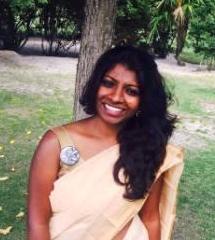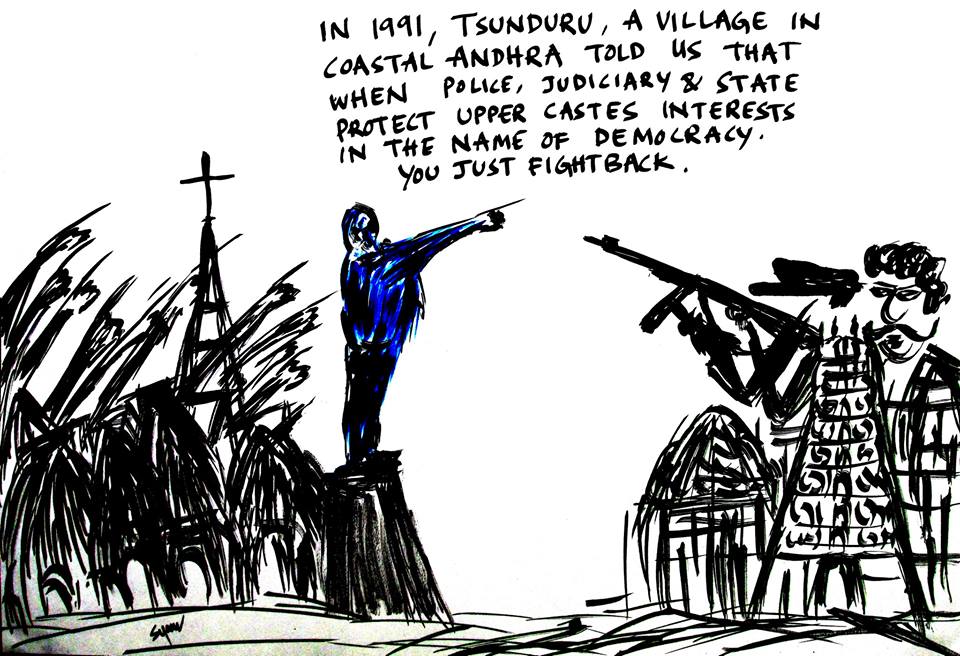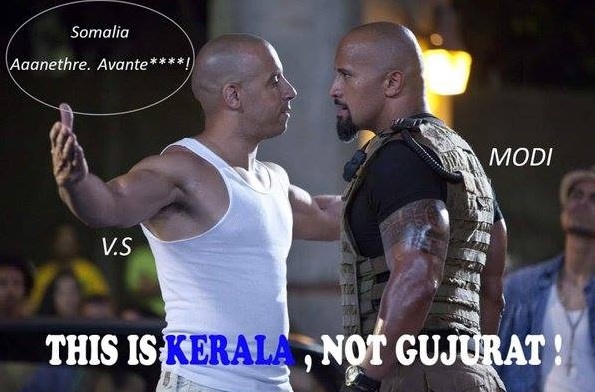Christina Thomas Dhanaraj
 “The oppressor is solidary with the oppressed only when he stops regarding the oppressed as an abstract category and sees them as persons who have been unjustly dealt with, deprived of their voice, cheated in the sale of their labor — when he stops making pious, sentimental, and individualistic gestures and risks an act of love. True solidarity is found only in the plenitude of this act of love, in its existentiality, in its praxis. To affirm that men and women are persons and as persons should be free, and yet to do nothing tangible to make this affirmation a reality, is a farce.”
“The oppressor is solidary with the oppressed only when he stops regarding the oppressed as an abstract category and sees them as persons who have been unjustly dealt with, deprived of their voice, cheated in the sale of their labor — when he stops making pious, sentimental, and individualistic gestures and risks an act of love. True solidarity is found only in the plenitude of this act of love, in its existentiality, in its praxis. To affirm that men and women are persons and as persons should be free, and yet to do nothing tangible to make this affirmation a reality, is a farce.”
~ Paulo Freire, Pedagogy of the Oppressed
I have come to believe that intersection is a beautiful thing. Not necessarily from the lens of the onlooker, but from within myself, for myself. The fact that I’m Dalit, Tamizh, Christian, Woman, and everything else could only mean there are layers to the person that I am, with every layer attributing me with experiences that make me complex and unique. So as a contemporary Dalit woman living in urban India, I recognize the path my ancestors and I have travelled to reach this place in history. Like many of my peers, I grew up listening to the stories of how our grandfathers and grandmothers moved from place to place; how they found jobs before they found a career; how they found a religion that promised the dignity Hinduism denied; how they navigated social, academic, and political spaces rife with discrimination; how they married and loved and had children amidst hate;and how they survived, and sometimes thrived, in a country that refused to recognize their humanity. I grew up seeing my parents carryon this legacy of assertion, at their workplace, at the church, in the community, and in our so-called social circles. Needless to say, this was no easy feat.
Who am I? Why am I a Dalit woman?
I grew up in a lower middle class family in a town on the outskirts of Chennai. And unlike many of my Christian friends, I came to know which caste I belonged to much earlier in life. I was probably 5 years of age when my mother sat me down, and almost in whispers, explained what our ancestors were made to do for a living. “They disposed of the dead”, she said. That those we saw dancing and playing the parai during a funeral, could in fact be our brothers. That they, and therefore we, were supposedly untouchable. I remember being very upset, refusing to believe what she told me. I may have even cried a little.
But perhaps similar to other Dalit (Christian) families, my parents tried their very best to shield us from the pain and trauma our caste locations would otherwise bring. And because I was a 3rd generation Christian, my primary label was that of an ‘Indian Christian’. All through my teenage, I stuck to it. I did not have a community certificate either, and was slotted under open competition, which meant I would not benefit from affirmative action. This lack of an official caste identity did not however grant me any social status. The Indian church, and specifically Tamizh CSI congregations, to which we belong to, are very adept at spotting caste markers of every family. This means that no matter how much one tries to distance oneself from his/her oppressed-caste identity, the community inside the church ensures that his/her label stays alive in their eyes. This means that inter-caste marriages will not happen. This means that unless one has enough class to help compensate, caste will continue to determine social acceptance and respect. And no, the fact that my grandfather and my maternal uncle were both presbyters did not help.
I was almost 20 when I finally found a platform that helped me unpack my caste location. Given that I grew up in a very non-politicized Christian context, I heard the word ‘Dalit’ for the first time only when I was in college. I took to it like I was waiting for it my whole life. The more I heard and the more I read, the more I understood how caste had shaped my experiences, and that of my family’s. The biology teacher who made me stand up in class and repeatedly asked me if I was really, really sure I came under OC, and not SC. The girl at my church who nonchalantly called me a parachi. The hesitation in attending weddings that screamed caste privilege. The gaze of the upper caste Christian families, and their talk of God’s blessings. The beef curry that we never spoke about.
Articulation of the Dalit identity, and from there on the Dalit woman’s identity, by my mentors at the Student Christian Movement, who were Dalits themselves, encouraged me to articulate my worldview that was unique and mine. I moved on from the writings of Divakaruni and Roy, who I had hoped will tell my story because they were Indian women, to that of Bama and Pawar, who actually did. I yearned for voices in literature that synced with mine. I yearned for voices everywhere life took me. While I had still not come out as Dalit, things seemed to be falling in place; my people were recognizing me, sisters across boundaries were sharing experiences, and my parents were telling us their stories. The fog was lifting.
Academic Jargon and Pretty Dresses: The Privilege Criticism
As far as my memory takes me, one thing had always remained constant in our families (immediate and extended) – the mandate to work hard. We were to work hard at school, and strive harder to find a job; not just any job but a career. Education and employment were non-negotiable. “Both your grandmothers were teachers; your maternal grandfather was a theologian; your paternal grandfather was an ex-serviceman. Do you know how much they had to struggle to get us here? You study. Period. You work. Period.” None of us women in the family even dared to explore the possibility of becoming homemakers. We simply could not afford to. Unlike our dominant/upper caste peers, we had no ancestral lands, close to no networks, and no monetary cushions. My cousins and I grew up watching our mothers and our fathers slog it out, at work, at home, and everywhere else.
Because my parents made some very tough choices, such as moving into the city regardless of the hardship it brought, putting us in English-speaking schools knowing well that tuitions were something they could not afford, pushing us to create a life that would demand the respect they had to fight for; we are where we are today. And my parents were able to make these choices because their parents had to make tougher choices and fight harder battles. Yet, despite all their efforts, we are not entirely protected from the storm that is determined to blow us out – the chasm is wide and deep, and we are building the bridge as we cross it. This means that we work hard too, that we take our opportunities seriously, that we not just show up but be ready to lead, that we push ourselves fiercely and passionately. This means that I don’t shy away from speaking in English, if that’s what it takes to tell my story to the world. This means that I be academically sound and be taken seriously in a country that has for so long not recognized my people’s intellect. This means that I wear the best of my clothes and walk with my head held high in a place that did not allow my mothers to cover their breasts.
Given this context of my experiences, and inspecific reference to the privilege criticism placed by savarna/other allies1,2,3,4 on English-speaking, ‘upwardly mobile’ Dalits such as myself, I would like to make a few points in response:
1. While privileges do exist within present-day Dalit communities, these are not in any measure close to the kind enjoyed by our upper caste counterparts. Caste oppression has been in practice for more than 20005 years and it is needless to say that our families face an inter-generational deficit of resources, land, and capital; that which would take several more economically secure generations to compensate. The gift of choice that we have received from our parents and our grandparents, who fought through massacres and beheadings; the gift that we are now fighting to keep; is not in any way comparable to the blatant privilege our oppressors are born with. Privilege within the Dalit community, whether it is class, social mobility, education, or others, should thus be defined with precision; and more importantly it should be defined by us, the Dalits.
2. Secondly, the ally (savarna, white, South-Asian, or any other) has no authority whatsoever to define the aforementioned type of privilege. To say that English-speaking Dalit women are taking away the space of other Dalit women1,3, is basically saying that to begin with, we have only a few spots to aspire for; and these spots cannot be taken up by the ‘already empowered’, ‘privileged’ Dalit women who ‘wear pretty dresses’ and ‘speak academic jargon’. If the ally (especially the savarna) is so concerned, why doesn’t he/she/they give up their spot, the one that has been held by their families for ages now? Why should the ally use our internal discourses on privilege as opportunities to disregard the voices of our women?
3. Thirdly, who gets to define what is the most authentic Dalit experience? Who defines what is Dalit-ness: “Are you Dalit-enough?”, “What is so Dalit about you?”, “You don’t look like a Dalit”. As Somwanshi points out6, “one needs to rightly situate the ‘Dalit-ness’ of a person as arising from someone’s ‘Brahmin-ness’, without which it wouldn’t exist…(However) Reification of the Dalit identity turns it into a commodity, something to be studied, critiqued, to be used and discarded in isolation, with full convenience for the Brahmin-savarna”. This implies that any Dalit man or woman who does not fit into the reified image of a helpless, voiceless victim, will not be accepted as an authentic-enough Dalit. His/her Dalit-ness will have to be justified, failing which their narrative will be dissed out as ‘too-privileged’.
Celebrating Our Ancestors, Our Sisters, and Ourselves
I’m a Dalit, middle class, university educated, Tamizh and English speaking, Christian, Woman. I’m an intersection of all these identities, and these constitute the basis to who I am, and who I will be in the years to come. No matter how the world sees me, I will hold the light of my ancestors, my mentors, my sisters, and Babasaheb close to my heart; knowing that I owe much to those who came before me, and need to give much more to the ones who will come after. I will not shy away from being fully human and living fully, simply because an ally or an oppressor is doling out hateful and reckless opinions on my life and my choices, and those of my sisters, under the guise of calling out privilege.
Margaret’s voice in 20057, which said, “I am a Dalit-middle-class, University educated, Telugu speaking Dalit-Christian-Woman. All these identities have a role in the way I perceive myself and the worlds I inhabit. I, as a Dalit woman, primarily write for Dalit women to uphold our interests. This statement of mine is necessary because if we do not define ourselves for ourselves, we will be defined by others – for their use and to our detriment. This voice is not representative of all Dalit women. However, I know that my voice is important because it is the voice of a socially denigrated category, suppressed and silenced”, is an important reminder to realize that our identities are ours only to define. Our lives and leadership, as Dalit women and Dalit men, cannot be controlled by the boundaries set by the oppressor, who may in some cases look like an ally or a friend.
Additionally, it is important that we celebrate ourselves and our ancestors, who believed that we were all capable of achieving a fuller humanity; who believed that there is hope in the darkest of times; and who acted on those beliefs. We have to celebrate our sisters, our brothers, who are all trying to cross the chasm, who we should join hands with, to get to the other side, quickly and safely. We have to celebrate our leadership within our movements, and work to find creative, more innovative ways to achieve the vision Babasaheb has set out for us. And we must always, always watch out for the oppressor, and not let their worldviews dictate our decisions or influence our love for one another.
~
Notes
* Parai: One of the oldest musical instruments of the Paraiyar community in Tamilnadu that has now become a symbol of liberation.
* CSI: Church of South India
* Presbyters: A Church minister of the second order under the authority of a bishop.
* OC: Open Competition
* Parachi: A hateful caste slur used against Paraiyar women
* Student Christian Movement (of India): One of the oldest youth ecumenical organizations of University students in India, formed in 1912.
* Divakaruni: Chitra Banerjee Divakaruni
* Roy: Arundhati Roy
* Bama: Bama Faustina Soosairaj
* Pawar: Urmila Pawar
* Theologian: An expert in theology (Christian theology in this context)
References
1. https://www.facebook.com/chandana.chandragiri/posts/10154723536749742
2. https://www.facebook.com/shruti.m.bhadra/posts/1419528568076518
3. https://www.facebook.com/sharmin.hossain.1293/posts/10157402517480032
4. https://www.facebook.com/insaneamar/posts/990660371055286
5. http://www.nbcnews.com/science/indias-caste-system-goes-back-2-000-years-genetic-study-6C10874609
6. http://roundtableindia.co.in/index.php?option=com_content&view=article&id=8748:dalit-identity-or-commodity-for-savarnas&catid=119:feature&Itemid=132
7. https://www.countercurrents.org/feminism-margaret030605.htm
For further reading
1. http://www.daga.org.hk/btr/btr9v/v95-3-20.htm
2. http://roundtableindia.co.in/index.php?option=com_content&view=article&id=8770:i-will-not-die-a-victim-i-want-to-live-as-a-leader-manisha-mashaal&catid=119:feature&Itemid=132
3. http://www.lionsroar.com/ambedkars-vision/
4. Analogous narratives: Interactions of class and race – http://www.classism.org/class-identity-woman-african-descent/
~~~
Christina Thomas Dhanaraj is a 3rd generation Christian Dalit woman from Bangalore, India. She is a co-founder of the Dalit history month collective (Dalithistory.com), and a volunteer for #dalitwomenfight. She currently works a business analyst.










